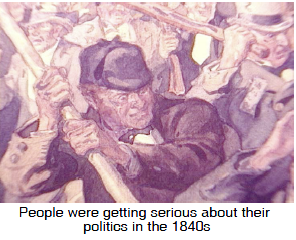Members of the first elected Assemblies were simply individuals who represented the people in the constituency: a district or
riding represented by an elected
member of a legislative body.constituency that had elected them. Through the 1840s, however, when the issue of responsible government: a
system of government in which
the executive (law makers)
must have the confidence
(support) of a majority in the
elected legislative assembly.responsible government was being argued, Assembly members began to take sides and form parties that stood for or against it.  Those supporting reform came to be called Liberals and those against it were called Tories or Conservatives.
Those supporting reform came to be called Liberals and those against it were called Tories or Conservatives.
Since responsible government relied on the executive branch (those who formed policies) having the "confidence" or support of the majority of the Assembly, it required that the Assembly divide itself into voting blocs which would support or oppose this executive. The group with the majority bloc stayed in power.
The drawback of this system was that the elected members of the Assembly would no longer put the interests of their constituency first. party discipline: this requires that members of a political party always vote the same way as their party leaders.Party discipline meant that the interests of the party came before the interests of the constituency. Between elections there was no real check on the power of the majority party since everyone in that party had to vote in agreement with the party executive. This is still the same today.
